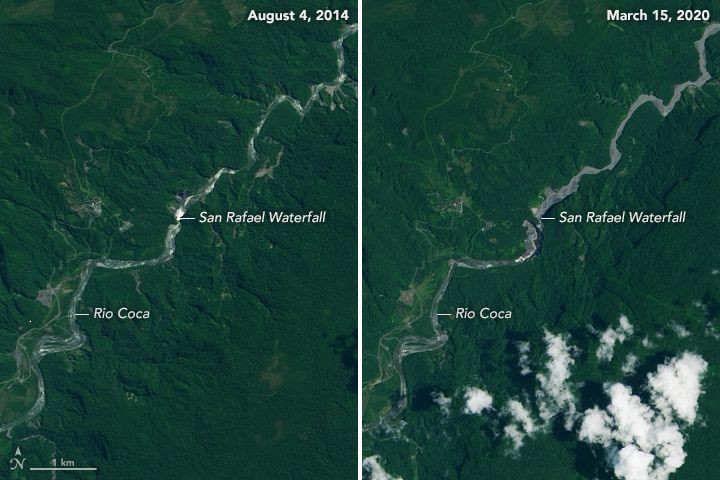NASA Satellite Images Show 'Disappearance' Of Ecuador's Tallest Waterfall
KEY POINTS
- Last February, a sinkhole appeared close to San Rafael waterfall, diverting the water flow
- Only trickles of water now flow along the once powerful waterfall
- The sinkhole may be natural or a result of human activity
The tallest waterfall in Ecuador, the San Rafael Waterfall, has now "disappeared." In satellite images, one can see how the cascade that used to bring in tens of thousands of visitors each year is no longer flowing.
Side-by-side images of the San Rafael Waterfall and its surrounding river basin show the stark difference in the waterfall, or what is left of it, from several years ago and today. In the earlier image, taken on Aug. 4, 2014, the waterfall is still flowing, as evidenced by the white patch indicating the waterfall's strong 150-meter drop. In a new satellite image of the area taken on March 15, the white waters indicating the waterfall is gone.

Evidently, the waterfall stopped flowing on Feb. 2 due to a massive sinkhole that appeared in the Coca River just a few meters before the falls. Because of it, instead of flowing through the San Rafael Waterfall, the water now flows in three separate, less steep courses a few meters behind it.
Now, only a steady, gentle flow falls from the area where the powerful waters used to fall and, the river flows under an arch that survived the collapse. The waterfall technically did not disappear but, instead, the river merely changed its course. However, it did lose what made it a massive tourist draw.
Why the sinkhole occurred is still under investigation but, according to experts, there could be both natural and human-related reasons behind it.
First, it is possible that sinkhole naturally occurred. They rarely happen but, when they do, they can vary in size from a few feet to hundreds of acres wide and less than 1 to over a hundred feet deep.
Another possibility is that sinkhole may have something to do with the Coca Codo Sinclair hydroelectric plant, which is one of the largest in the country and is just 20 kilometers upstream from the San Rafael waterfall.
Although the Coca Codo Sinclair plant is not exactly located in the river, its diversion reservoir system has sand traps that remove river sediment. According to experts, losing river sediments could increase its "erosive capacity."
As it happens, the Coca Codo Sinclair plant was only inaugurated in 2016.
Whether the waterfall "disappeared" due to natural causes or because of indirect response to the hydroelectric plant, Ecuador has no plans of reconstructing San Rafael Waterfall.
© Copyright IBTimes 2025. All rights reserved.






















